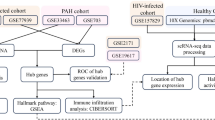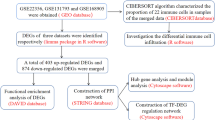Abstract
Background
Pulmonary arterial hypertension (PAH) is a deadly disease, and the molecular mechanism of PAH has not been clarified clearly. The objective of this study was to identify possible biomarkers and explore the potential mechanisms of Schistosoma-induced PAH.
Methods
GSE49114 RNA-Seq data developed from mouse whole lung tissues were downloaded from the Gene Expression Omnibus database. Differentially expressed genes (DEGs) between control samples and schistosomiasis-induced PAH samples were identified by the edgeR software. Gene Ontology (GO) and pathway enrichment analysis of DEGs were performed, followed by metabolic pathway network construction. Moreover, pathways with higher connectivity degrees in the metabolic pathway network were identified.
Results
Totally, 877 up- and 520 downregulated DEGs were screened. The upregulated DEGs such as IL-4 (Interleukin-4) were significantly related with immune system process, transmembrane signaling receptor activity, and signal transducer activity. Downregulated DEGs (i.e., Smad9 (SMAD family member 9), BMPR2 (bone morphogenetic protein type 2 receptor), and Eng (endoglin)) were significantly enriched in signal transducer activity, growth factor binding, and signal transduction. The top 10 metabolic pathways with highest connectivity degree were screened, including leishmaniasis (degree = 26), antigen processing and presentation (degree = 20), hematopoietic cell lineage (degree = 20), chemokine signaling pathway (degree = 18), and JAK–STAT signaling pathway (degree = 18).
Conclusions
Smad9, BMPR2, Eng and IL4, and their relative functions such as signal transduction, signal transducer activity, and immune system process might play important roles in schistosomiasis-induced PAH. Moreover, the interaction of metabolic pathways was critical in the development of schistosomiasis-PAH.




Similar content being viewed by others
References
Galiè N (2004) Pulmonary arterial hypertension: epidemiology, Pathobiology, assessment, and therapy. Elsevier, Amsterdam
de Cleva R, Herman P, Pugliese V et al. (2002) Prevalence of pulmonary hypertension in patients with hepatosplenic masonic schistosomiasis–prospective study. Hepato-gastroenterology 50:2028–2030
Butrous G (2014) Saudi guidelines on the diagnosis and treatment of pulmonary hypertension: schistosomiasis and pulmonary arterial hypertension. Ann Thorac Med 9:S38
Humbert M, Sitbon O, Chaouat A et al (2006) Pulmonary arterial hypertension in France: results from a national registry. Am J Respir Crit Care Med 173:1023–1030
McLaughlin V (2011) Looking to the future: a new decade of pulmonary arterial hypertension therapy. Eur Respir Rev 20:262–269
Dorfmüller P, Perros F, Balabanian K et al (2003) Inflammation in pulmonary arterial hypertension. Eur Respir J 22:358–363
Morrell NW (2010) Role of bone morphogenetic protein receptors in the development of pulmonary arterial hypertension. In: Membrane receptors, channels and transporters in pulmonary circulation. Springer, New York, p 251–264
Chandra SM, Razavi H, Kim J et al (2011) Disruption of the apelin-APJ system worsens hypoxia-induced pulmonary hypertension. Arterioscler Thromb Vasc Biol 31:814–820
Graham BB, Chabon J, Kumar R et al (2013) Protective role of IL-6 in vascular remodeling in schistosoma pulmonary hypertension. Am J Respir Cell Mol Biol 49:951–959
Tuder RM (2009) Pathology of pulmonary arterial hypertension. In: Seminars in respiratory and critical care medicine. © Thieme Medical Publishers, Stuttgart, p 376–385
Pickrell JK, Marioni JC, Pai AA et al (2010) Understanding mechanisms underlying human gene expression variation with RNA sequencing. Nature 464:768–772
Marguerat S, Bähler J (2010) RNA-seq: from technology to biology. Cell Mol Life Sci 67:569–579
Graham BB, Chabon J, Gebreab L et al (2013) Transforming growth factor-β signaling promotes pulmonary hypertension caused by Schistosoma mansoni. Circulation 128:1354–1364
Kumar R, Mickael C, Chabon J et al (2015) The causal role of IL-4 and IL-13 in Schistosoma mansoni pulmonary hypertension. Am J Respir Crit Care Med 192:998–1008
Barrett T, Troup DB, Wilhite SE et al (2007) NCBI GEO: mining tens of millions of expression profiles—database and tools update. Nucleic Acids Res 35:D760–D765
Sherry S (2012) NCBI SRA Toolkit Technology for Next Generation Sequence Data. In: Plant and Animal Genome XX Conference. Plant and Animal Genome
Joshi NA Fass JN (2011) Sickle: a sliding-window, adaptive, quality-based trimming tool for FastQ files (Version 1.33) [Software]. https://github.com/najoshi/sickle.
Langmead B, Salzberg SL (2012) Fast gapped-read alignment with Bowtie 2. Nat Methods 9:357–359
Kim D, Pertea G, Trapnell C et al (2013) TopHat2: accurate alignment of transcriptomes in the presence of insertions, deletions and gene fusions. Genome Biol 14:R36
Trapnell C, Williams BA, Pertea G et al (2010) Transcript assembly and quantification by RNA-Seq reveals unannotated transcripts and isoform switching during cell differentiation. Nat Biotechnol 28:511–515
Quinlan AR, Hall IM (2010) BEDTools: a flexible suite of utilities for comparing genomic features. Bioinformatics 26:841–842
Robinson MD, McCarthy DJ, Smyth GK (2010) edgeR: a Bioconductor package for differential expression analysis of digital gene expression data. Bioinformatics 26:139–140
Consortium G O (2004) The gene ontology (GO) database and informatics resource. Nucleic Acids Res 32:D258–D261
Kanehisa M, Goto S (2000) KEGG: kyoto encyclopedia of genes and genomes. Nucleic Acids Res 28:27–30
Young MD, Wakefield MJ, Smyth GK et al. (2010) Method gene ontology analysis for RNA-seq: accounting for selection bias. Genome Biol 11(2):1
Benjamini Y, Drai D, Elmer G et al (2001) Controlling the false discovery rate in behavior genetics research. Behav Brain Res 125:279–284
Dutta B, Wallqvist A, Reifman J (2012) PathNet: a tool for pathway analysis using topological information. Source Code Biol Med 7:10. doi:10.1186/1751-0473-7-10
Dutta B, Wallqvist A, Reifman J (2012) PathNet: a tool for pathway analysis using topological information. Source Code Biol Med 7(1):1
Yu C, Zavaljevski N, Desai V et al (2011) QuartetS: a fast and accurate algorithm for large-scale orthology detection. Nucleic Acids Res 39:e88. doi:10.1093/nar/gkr308
Yu C, Desai V, Cheng L et al (2012) QuartetS-DB: a large-scale orthology database for prokaryotes and eukaryotes inferred by evolutionary evidence. BMC Bioinform 13:143. doi:10.1186/1471-2105-13-143
Malenfant S, Neyron A-S, Paulin R et al (2013) Signal transduction in the development of pulmonary arterial hypertension. Pulmonary circulation 3:278
Miyazono K, Ten Dijke P, Heldin C-H (2000) TGF-β signaling by Smad proteins. Adv Immunol 75:115–157
Runo JR, Vnencak-Jones CL, Prince M et al (2003) Pulmonary veno-occlusive disease caused by an inherited mutation in bone morphogenetic protein receptor II. Am J Respir Crit Care Med 167:889–894
Chaouat A, Coulet F, Favre C et al (2004) Endoglin germline mutation in a patient with hereditary haemorrhagic telangiectasia and dexfenfluramine associated pulmonary arterial hypertension. Thorax 59:446–448
Austin ED, Ma L, LeDuc C et al (2012) Whole exome sequencing to identify a novel gene (caveolin-1) associated with human pulmonary arterial hypertension. Circulation 5:336–343
Humbert M, Morrell NW, Archer SL et al (2004) Cellular and molecular pathobiology of pulmonary arterial hypertension. J Am Coll Cardiol 43:S13–S24
Rudarakanchana N, Flanagan JA, Chen H et al (2002) Functional analysis of bone morphogenetic protein type II receptor mutations underlying primary pulmonary hypertension. Hum Mol Genet 11:1517–1525
Grijelmo C, Rodrigue C, Svrcek M et al (2007) Proinvasive activity of BMP-7 through SMAD4/src-independent and ERK/Rac/JNK-dependent signaling pathways in colon cancer cells. Cell Signal 19:1722–1732
Massagué J, Chen Y-G (2000) Controlling TGF-β signaling. Genes Develop 14:627–644
Graham BB, Kumar R (2009) Schistosomiasis and the Pulmonary Vasculature. Hypertension 1954:S43–S54
Graham BB, Mentink-Kane MM, El-Haddad H et al (2010) Schistosomiasis-induced experimental pulmonary hypertension: role of interleukin-13 signaling. Am J Pathol 177:1549–1561
Pittet J-F, Griffiths MJ, Geiser T et al (2001) TGF-β is a critical mediator of acute lung injury. J Clin Invest 107:1537–1544
Masri FA, Xu W, Comhair SA et al (2007) Hyperproliferative apoptosis-resistant endothelial cells in idiopathic pulmonary arterial hypertension. Am J Physiol-Lung Cell Mol Physiol 293:L548–L554
Kisseleva T, Bhattacharya S, Braunstein J et al (2002) Signaling through the JAK/STAT pathway, recent advances and future challenges. Gene 285:1–24
Crosby A, Soon E, Jones FM et al (2015) Hepatic shunting of eggs and pulmonary vascular remodeling in Bmpr2+/− mice with schistosomiasis. Am J Respir Crit Care Med 192:1355–1365
Author information
Authors and Affiliations
Corresponding author
Ethics declarations
Conflict of interest
The authors have not declared any conflicts of interest.
Rights and permissions
About this article
Cite this article
Sun, Y., Lin, X. & Li, L. Identification of Biomarkers for Schistosoma-Associated Pulmonary Arterial Hypertension Based on RNA-Seq Data of Mouse Whole Lung Tissues. Lung 195, 377–385 (2017). https://doi.org/10.1007/s00408-017-9999-z
Received:
Accepted:
Published:
Issue Date:
DOI: https://doi.org/10.1007/s00408-017-9999-z




